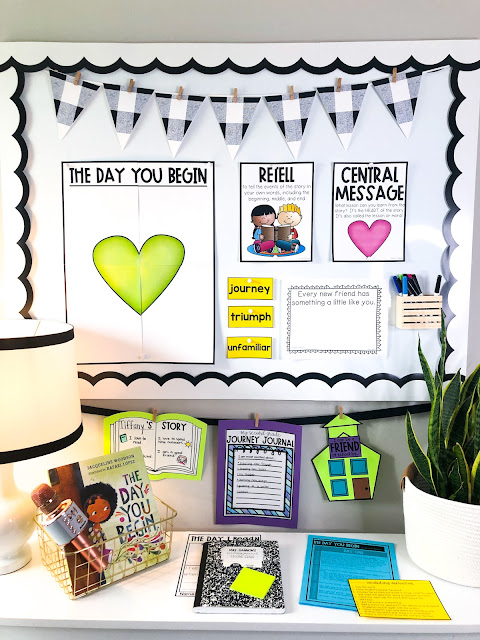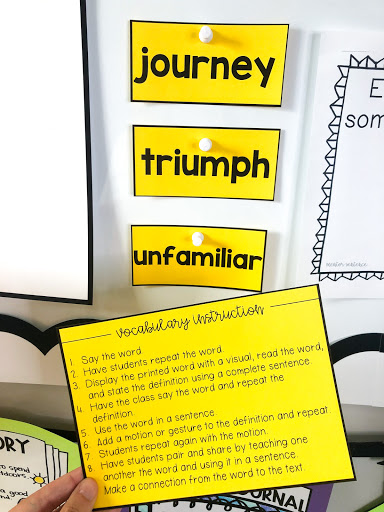
Interactive Read Alouds allow us to teach a broad range of standards within one text. This month's read aloud lessons focus on the Key Ideas and Details and Craft and Structure standards in Literature for Second Grade. They cover answering questions using key details from the text, recounting the story, determining the central message, describing how characters respond to major events and challenges, and describing the overall structure of the story. The books were chosen based on the needs of students returning back to school. These books contain themes of bravery, inclusion, kindness, growth mindset, and names. Although each week's lessons cover a broad range of standards, there is a focus for assessment purposes on one specific standard. The first two weeks in this particular set do not end with a multiple choice assessment, just because it's the beginning of the school year. You could use the final task those weeks for a grade if needed.
The read aloud lessons are designed to cover five days per text and include anchor charts, posters, daily lesson plans, assessing and advancing questions for partner talk and response to reading, printable sticky note questions, vocabulary, vocabulary instruction routine, daily independent tasks, crafts, mentor sentences, and DIGITAL Google Slides TM lessons for each week (these are AMAZING for distance learners and in your own classroom to guide your instruction).
August Second Grade Interactive Read Aloud Lessons (Printable and Google Slides TM)
This month's read aloud texts include:
If you do not want to buy all of these books at once, check with your school's or your community's library. I know that some of these titles can be priced a little higher at back to school time.
Standards covered:
RL 2.1 Ask and answer such questions as who, what, where, when, why, and how to demonstrate understanding of key details in a text.
RL 2.2 Recount stories, and determine their central message, lesson, or moral.
Rl 2.3 Describe how characters in a story respond to major events and challenges.
RL 2.5 Describe the overall structure of a story, including how the beginning introduces the story and the ending concludes the action.
Here is a little set up of a focus board you might include in your classroom. I like to keep these displayed throughout the unit of study. The anchor chart can be printed as a poster on your own printer following the steps included in the resource. I have also included posters for the standards-based strategies or skills covered for the month.
There is a lesson plan included for each of the five days of the week that contains a scripted mini-lesson, text dependent questions to ask during the reading aloud, a daily independent task in which students respond to the text, partner share, and an exit ticket.
The sticky note questions can be placed inside your book, so that you are always prepared ahead of time. No need to worry about coming up with questions on the fly. They are organized by key ideas and details, craft and structure, and integration of knowledge ideas type questions. I like to turn the sticky notes sideways when I print, so that I can cut them apart and place on the pages that I want to stop and pose the question to students. At that point, they will discuss the question with their partner using accountable talk strategies. We then come back together to discuss responses. This ensures that everyone is engaged during your read aloud.
Each story contains 3-4 vocabulary words from the text. I use this instructional routine to teach the words. In the digital component, I also include cards that contain the word, definition, sentence, and an illustration along with a simple task to complete each day.
The anchor charts are based on the focus standard for the week. This one is to work on describing the overall structure of a story. You will want to create these with students. You can also use these with other texts throughout the year.
Here is an example of the posters, all standards-based. Now let's take a look at the independent tasks that students will complete each day. They will need a journal for many of the tasks.
Assessments for Each Kindness and The Name Jar are based on the focus standard and include four multiple choice questions and a short written response question.
Each of the crafts and directed drawing included are standards based, so no need to worry about justifying why you are incorporating art into your lessons.
Finally, I do include a mentor sentence for each week to review language standards while also tying into your text for the week. I print the large one for myself and students receive the individual words from the sentence. They put these in order in their journals. There space below for an illustration on both. You will then start identifying parts of the sentence and color coding them, such as color the nouns yellow and the verbs purple.

The best part of the whole resource might be these digital Google Slides TM. I took the PowerPoints that I used in my classroom and converted them to Google Slides TM. This way, you can assign the slides needed to your virtual or distance learners and they can complete their responses to the task and submit back to your for feedback. Different schools have different expectations for virtual learning, so I tried to meet all of those. You might be doing recorded or live lessons, either way you can send this to students to complete individually on their own time or during your live lessons. They follow the exact structure of the lesson and even have fun embedded videos including the story. I do highly recommend, however, that you read the book to the students. That way you are developing that connection with them and are able to stop at certain points to discuss the provided questions. You can also clearly state your expectations for the students tasks.
Even if you are doing in person learning this year, you can use these during your lesson. Just project them on your board to guide you through the different components of your lesson. You can take a look below at the digital lessons. I have included a video preview that explains them in more detail on the listing. These are also sold individually and in a digital only bundle. There is a free version of a first grade lesson HERE if you want to download that first to see if it would help you with your distance learning assignments. The goal of these was to make your life easier. It's so much to convert your lessons into digital right now with everything else going on.
Thank you for reading and I hope these lessons benefit your students this year! I know they have been incredible for my my students in growing as readers, writers, and good citizens. :)

























No comments
Post a Comment
Note: Only a member of this blog may post a comment.